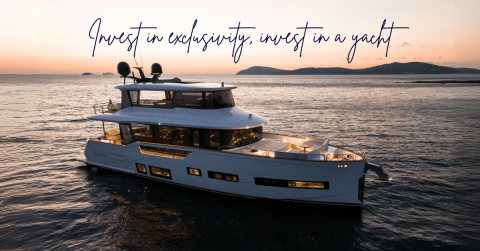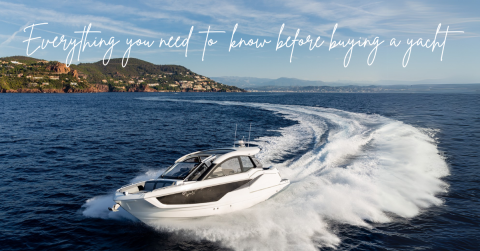Owning a yacht is more than acquiring a vessel—it’s embracing a lifestyle of freedom, elegance, and unforgettable experiences at sea. Whether you…

The Importance of Gross Tonnage (GT) in Luxury Yachts in the United States
Gross Tonnage (GT), also known as internal volume tonnage, is a key metric in the yachting industry—especially for large yachts and superyachts sailing under the U.S. flag or in international waters.
While many first-time buyers focus on length (LOA), GT reflects the vessel’s total internal volume, making it the most accurate measurement of habitable space, applicable regulations, and operating costs.
In this guide, we’ll explore what GT means, how it’s calculated, its legal and operational implications in the U.S., and when to prioritize length versus gross tonnage. You’ll also learn about regulatory thresholds that directly impact owners.
What Is Gross Tonnage (GT) and How Is It Calculated?
GT doesn’t measure the weight of the yacht—it represents the total internal volume, including all enclosed spaces: cabins, salons, engine rooms, technical decks, etc.
Since 1969, the International Maritime Organization (IMO) has standardized the GT calculation using the formula:
GT = K × V, where:
- V = internal volume in cubic meters
- K = 0.2 + 0.02 × log₁₀(V)
This standard ensures global consistency, allowing yachts of different shapes and sizes to be compared on the same scale.
When to Focus on Length vs. Gross Tonnage (GT)
Both measurements matter—but they serve different purposes.
Length Overall (LOA):
- Commonly used for small to midsize yachts
- Relevant when selecting a marina, estimating dockage fees, or choosing berths
- Frequently referenced in brochures, listings, and base pricing
Gross Tonnage (GT):
- Crucial for large yachts, superyachts, and commercial vessels
- Determines the regulatory framework applicable under USCG and IMO rules
- Influences port fees, licensing, required crew size, and onboard safety systems
- Better reflects onboard volume and luxury potential
In short:
- Interested in looks, handling, and marina access? → Look at length.
- Want to understand the yacht’s true scale, comfort, and legal profile? → Look at GT.
Key GT Thresholds That Trigger U.S. Regulations
Certain GT milestones directly affect the yacht’s legal classification and requirements:
300 GT
- International Tonnage Certificate becomes mandatory
- USCG inspections increase in frequency and scope
- More extensive safety systems and certified crew are required
500 GT
- Full enforcement of SOLAS (Safety of Life at Sea) regulations
- Compliance with the ISM Code (International Safety Management)
- Advanced GMDSS communication systems, stronger fire suppression, and additional lifeboats become mandatory
- Crew must hold U.S. Merchant Mariner credentials or equivalent international licenses
Many shipyards design superyachts to remain just under 500 GT to reduce operational costs and regulatory burdens—a strategic balance between luxury and compliance.
The U.S. Regulatory Context: Documents and Compliance
In the United States, GT is regulated by both the U.S. Coast Guard and IMO guidelines. Depending on the port of registration, the following may apply:
- Tonnage Certificate: Official document certifying the vessel’s GT, required for international navigation
- USCG Inspections: More rigorous and frequent as GT increases
- Port Fees and Taxes: Many U.S. ports calculate dockage and taxation based on GT, not just length
- Charter Operations: If the yacht is used for commercial charter, exceeding 300 or 500 GT significantly increases regulatory demands
GT as a Metric for Luxury and Design
Today’s superyachts aren’t just designed for length—they’re engineered to maximize interior volume (GT).
Example:
- A 45-meter yacht with 300 GT may feel more compact
- A 45-meter yacht with 480 GT offers larger saloons, more staterooms, and technical space—but comes with added compliance and crew requirements
GT has become a badge of prestige in top U.S. and European shipyards, symbolizing both design sophistication and comfort.
Camino al Mare: Expert Guidance for the U.S. Market
At Camino al Mare, we go beyond helping you choose the right yacht—we help you understand its Gross Tonnage (GT), anticipate U.S. Coast Guard regulations, and fully leverage the yacht’s interior volume and luxury potential.
Led by Roberto Camino, our founder and senior consultant, our team guides you through:
- Yacht selection in the U.S. or Europe
- Importation and registration under the optimal flag
- Compliance with international certifications and regulatory standards
- Preparation for charter, private cruising, or transatlantic voyages
Relacionados
Buying a yacht is an exciting decision—one that blends passion, lifestyle, and a significant investment.Whether you’re considering acquiring your yacht in the…


